The tree that time forgot (for a few million years)
The story of 'one of the most dramatic comebacks in natural history'.
On my recent holiday, I came face to face with a living fossil. Or, as our tour guide called it, a ‘pineosaur’.
I’m talking about the Wollemi pine. It’s an evergreen tree of the conifer family, which, until 1994, was believed to have been extinct for two million years.
Before its miraculous rediscovery in a national park, north-west of Sydney, Australia, it was only known in the fossil record.
It was by chance that an abseiling national park worker, descending into a remote canyon surrounded by tall sandstone cliffs, discovered the trees. David Noble was intrigued by the species – some as tall as 40metres with trunks around 1metre in diameter – which had characteristics of both pines and ferns. He didn’t recognise it, so he grabbed a little sample to examine later. When Noble showed that sample to an expert, who in turn showed it to some more experts – who then returned to the site to gather further samples – they eventually determined it as a new species and genus in the ancient family Araucariaceae.
Araucariaceae has fossil representation dating back to at least the Jurassic period (around 200-145 million years ago), when Australia was still part of the Gondwana supercontinent. The trees would have been a common species at the time, but the drying of the climate over millennia has reduced them to just a small grove of survivors.
The Wollemi pine was officially described in the March-September 1995 volume of ‘Telopea’, the botanical journal of the National Herbarium of New South Wales. It’s scientific name, Wollemia nobilis, is taken from the location where it was found – Wollemi National Park (from the Aboriginal word ‘wollumii’, which means 'look around you' or 'watch your step') – and its discoverer, David Noble.
Carrick Chambers, then-director of Sydney’s Royal Botanic Garden, described the discovery as “the equivalent of finding a small dinosaur alive on Earth”.
The trees are only known to exist in that remote gorge in the Wollemi National Park. Fewer than 100 mature individuals remain in the wild. Some of them are estimated to be up to a thousand years old.
To protect the pines – which are considered among the oldest and most endangered plants on the planet – their exact location is kept secret. The National Parks and Wildlife Service told me the site has been declared an Asset of Intergenerational Significance “in recognition of the [trees’] extraordinary global significance”.
So precious are the Wollemi pines, that during the 2019-2020 bushfires which swept through the area, a special team of remote area firefighters was deployed to help defend the trees. Images of the surviving green gorge surrounded by charred bushland are incredible.
An innovative model of propagation and distribution has been developed to ensure the long-term survival of the species.
Offspring of the Wollemi pines are now growing in botanic gardens around the world, including Kew in London, and commercial sales are helping fund the conservation of the wild survivors.
That’s right – you can buy a living fossil; a pineosaur of your own! (And yes, I have been in touch with my local Wollemi pine distributor – apparently they do very well in pots and can even be grown indoors!)
Remarkable botanicals
Want a couple more extraordinary examples from the plant kingdom?
Hyperion is the name that’s been given to a 115metre-tall coast redwood (Sequoia sempervirens) located in California's Redwood National Park. It is considered the tallest tree in the world.
A seagrass, Posidonia australis, off the coast of Western Australia, is believed to be the biggest plant on Earth. It covers an area over 200kilometres-square and scientists say it began growing from a single seed around 4,500 years ago.








